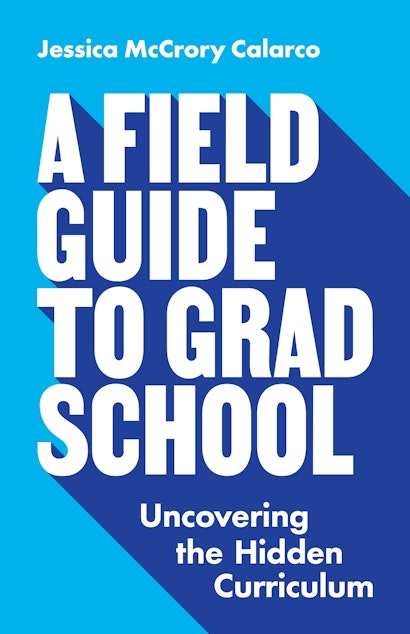Even in “normal” times, grad school is fraught with uncertainty—uncertainty around whether a degree is worth it, whether you picked the right program and whether they were smart to pick you, whether you can get enough funding to keep doing your work, whether you can publish enough to get a job, and whether there even will be any jobs when you’re done.
I wrote A Field Guide to Grad School to help students navigate through the uncertainties of grad school and understand the hidden forces that created those uncertainties and maintain them over time.
Learning to navigate grad school’s uncertainties is especially important in this current moment, where the COVID-19 pandemic is amplifying “normal” uncertainties and creating new ones, as well. That includes uncertainty about:
- Whether grad programs will be admitting new students, what they’ll require from applicants test-wise, and whether they’ll have the funds to support current students through setbacks and delays
- Whether classes will be online or in person, whether you can even get to campus, whether it’s even safe to be there, and why campuses are reopening at all
- Whether you’ll face new research restrictions, and whether you’ll get the funding you need to do your work
- Whether you’ll be able to stay on track in your program if you get sick or if you have to care for loved ones while schools and other care facilities are closed
- Whether conferences and interviews will be held online or in person and how to navigate those spaces, especially if you’re trying to get a job
- Whether the job market will stay frozen, and how to adjust your long-term plans
- Whether you have any power to push back and challenge university decisions, and what consequences you might face if you do
Navigating through these uncertainties will require up-to-the-minute facts about current health conditions and current policy decisions at the campus, state, and national level. To that end, and building on the insights that I share in A Field Guide to Grad School, I’ve decided to write a newsletter for grad students and students thinking about grad school in these deeply uncertain times.
In these newsletters, I’ll help you make sense of the latest decisions from higher ed. We’ll talk about what’s motivating those decisions. What impact they might have on the uncertainties and inequalities that already exist in academia. And how you can navigate the changing conditions and stay on track in the years ahead. As in A Field Guide to Grad School, I’ll ground these discussions in evidence from research and from my own experience as a professor, a former grad student, and a working mother juggling care responsibilities with a demanding academic career.
In an ideal world, you could count on your department and your advisor to help you navigate the new uncertainties of academia. And yet, as I explain in the book, faculty members have little incentive to provide that kinds of hands-on mentoring. Instead, the incentive structures of academia push faculty to focus as much of their time as possible on doing and publishing research. As a result, the professors who do commit to quality mentoring (many of them women scholars of color) tend to be overburdened with students and service commitments, and they’re rarely rewarded for that work.
My goal in the book is to offload some of that burden. To give you concrete advice and information you might otherwise get from a dedicated advisor. And also to give you strategies you can use to ask for help in figuring out the rest. The book has email templates for contacting faculty with common questions and requests. Note-taking guidelines for reading academic books and articles. A step-by-step plan to prepare for qualifying exams. Definitions of key terms (like qualifying exams). Suggested outlines for writing academic articles. And lots of notes on giving effective conference talks, teaching for empathy and equity, and balancing the demands of academia with life outside of work.
Essentially, A Field Guide to Grad School uncovers key parts of grad school’s hidden curriculum—the things you probably won’t be taught but are still expected to know. As I explain in the book, access to that kind of hidden knowledge tends to be highly stratified. Privileged students—those who are white, affluent, male, cis-gender, heterosexual, native-born, and able-bodied—have advantages that make it easier for them to learn the hidden curriculum of grad school. And those advantages lead to big rewards, like getting into “top” programs, getting picked for fellowships and grants, getting published in “top” journals, and getting hired for “top” jobs. By uncovering key parts of the hidden curriculum, the book aims to reduce some of that unfair advantage and the unequal outcomes it creates.
Of course, one book can’t cover a whole curriculum, hidden or otherwise. And that’s where the newsletter comes in. My hope is that the newsletter, in conjunction with discussions on Twitter (where you can find me @JessicaCalarco), will provide a space for grad students to make sense of the new uncertainties of academia and the normal ones, as well.
If you sign up for the newsletter or check out the book, please share them with others, as well. Uncovering key parts of the hidden curriculum can help level the playing field. But an even better solution is to dismantle that hidden curriculum and make necessary knowledge part of the formal curriculum, instead. Similarly, offering advice on navigating the uncertainties of grad school can help students in the short term. But it doesn’t fix the conditions that make grad school so destabilizing in the first place.
Unfortunately, grad students can’t change curriculum or conditions on their own. Certainly, grad students create pressure for change. But change almost never happens without the consent of those in power. And that means that if we want real change in academia, we’ll need faculty members, administrators, and probably a few policymakers on board.
Jessica McCrory Calarco is associate professor of sociology at Indiana University and the author of Negotiating Opportunities: How the Middle Class Secures Advantages in School. She has written for the Atlantic and Inside Higher Ed, and her work has been featured in the New York Times, Time, and the Chronicle of Higher Education, and on BBC Radio and NPR. Twitter @JessicaCalarco

